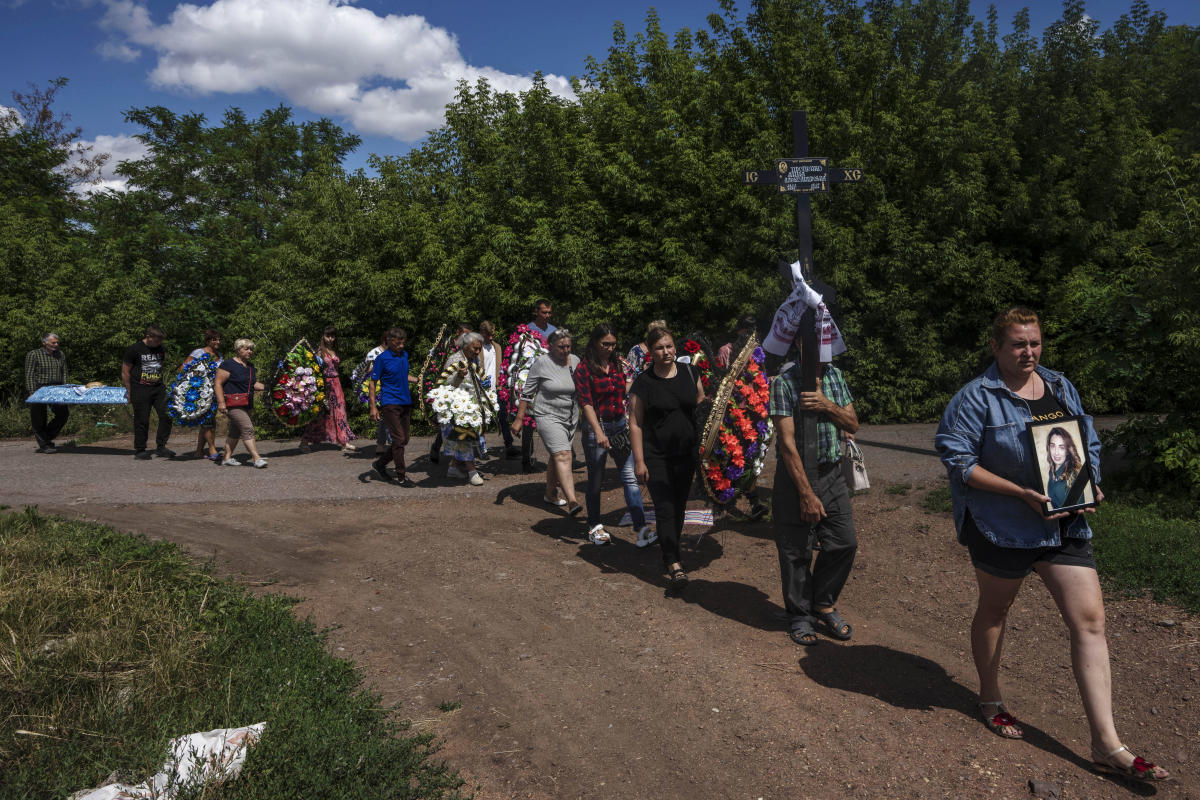Watch: Evacuees return to Donetsk homes when money runs out
POKROVSK, Ukraine (AP) – The rocket’s impact threw the young woman against the fence so hard that it shattered. Her mother found her dying on the bench under the pear tree where she had enjoyed the afternoon. By the time her father arrived, she was gone.
Anna Protsenko was murdered two days after returning home. The 35-year-old had done what the authorities wanted: She evacuated the Donetsk region of eastern Ukraine as Russian troops moved closer. But starting a new life elsewhere had been uncomfortable and expensive.
Like Protsenko, tens of thousands of people at significant risk have returned to rural or industrial communities close to the region’s front lines because they cannot afford to live in safer places.
Protsenko had been trying it out for two months, then came home to take a job in the small town of Pokrovsk. On Monday, friends and family stroked her face and cried before her coffin was slammed shut next to her grave.
“We cannot win. They don’t hire us anywhere else and you still have to pay rent,” says a friend and neighbor, Anastasia Rusanova. There’s nowhere to go, she said, but here in Donetsk, everything is ours.
The Pokrovsk mayor’s office estimates that 70% of those evacuated have returned home. In the larger city of Kramatorsk, an hour’s drive closer to the front lines, officials said the population had fallen to about 50,000 from the normal 220,000 in the weeks following the Russian invasion, but has since risen to 68,000.
It is frustrating for the Ukrainian authorities because some civilians remain in the path of war, but also the residents of the Donetsk region are frustrated. Some described feeling unwelcome as Russian speakers among Ukrainian speakers in some parts of the country.
But more often than not, lack of money was the problem. In Kramatorsk, some people waiting in line for boxes of humanitarian aid said they were too poor to evacuate at all. Donetsk and its economy have been ravaged by conflict since 2014, when Russian-backed separatists began fighting the Ukrainian government.
“Who takes care of us?” asked Karina Smulska, who returned to Pokrovsk a month after her evacuation. Now, at age 18, she is her family’s main money earner as a waitress.
Volunteers have been driving around the Donetsk region for months since the Russian invasion to help evacuate vulnerable people, but such efforts can quietly end in failure.
Watch: Officials share video of the aftermath of the Russian attack
In a damp house in the village of Malotaranivka on the outskirts of Kramatorsk, speckled strands of flypaper hung from the living room ceiling. Pieces of cloth were stuffed into the window cracks to keep out the draft.
Tamara Markova, 82, and her son Mykola Riaskov said they spent just five days as evacuees in the central city of Dnipro this month before deciding to take their chances back home.
“We would be separated,” Markova said.
The temporary shelter where she stayed said she would be moved to a nursing home and that her son, his left side immobilized after a stroke, would go to a home for the disabled. They found that unacceptable. In their haste to leave, they left his wheelchair behind. It was too big to take on the bus.
Now they do. When the air raid siren sounds, Markova takes shelter with the neighbors “until the bombing stops”. Humanitarian aid is provided once a month. Markova calls it good enough. When winter comes, neighbors will cover their windows with plastic wrap for basic insulation and clean the fireplace from soot. Maybe they have gas for heating, maybe not.
“It was much easier under the Soviet Union,” she said of their lack of support from the state, but she was even more unhappy with Russian President Vladimir Putin and what his soldiers are doing to the communities around her.
“He’s old,” she said of Putin. “He should retire.”
Homesickness and uncertainty also lead to return to Donetsk. A daily evacuation train departs from Pokrovsk for the relatively safer western Ukraine, but another train arrives every day with people who have decided to come home. The evacuation train is free, the return train is not.
Oksana Tserkovnyi took the train home with her 10-year-old daughter two days after the deadly July 15 attack in Dnipro, where they had stayed for more than two months. Although the attack provided the spark to return, Tserkovnyi struggled to find work. Now she plans to return to her previous job in a coal mine.
Costs in Dnipro, already packed with evacuees, were another concern. “We were staying with relatives, but if we had to rent, it would have been much more,” Tserkovnyi said. “It starts at 6,000 hryvnia ($200) a month for a studio, and you won’t be able to find it.”
Taxi drivers waiting for the arriving train in Pokrovsk said many people are giving up to settle elsewhere.
“Half of my job is definitely taking these people,” said one driver, Vitalii Anikiieev. “Because the money is gone.”
In mid-July, he said, he picked up a woman who came home from Poland after feeling out of place there. When they reached her village near the front line, there was a crater where her house had stood.
“She was crying,” Anikiieev said. “But she decided to stay.”
____
Associated Press journalist Inna Varenytsia contributed.
____
Follow AP’s coverage of fighting in Ukraine at https://apnews.com/hub/russia-ukraine

